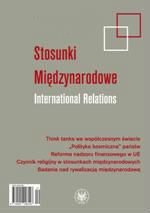Arktyka – region współpracy czy konfliktów
Arctic – a region of cooperation or conflicts
Author(s): Janusz SymonidesSubject(s): Politics / Political Sciences
Published by: Wydawnictwa Uniwersytetu Warszawskiego
Keywords: arctic; cooperation; conflict; conflicts; warming; melting; ice; resources; ice cold war; Norway; Arctic Ocean; Arctic States
Summary/Abstract: The Arctic is warming nearly twice as rapidly as the rest of the world. Reduction in sea-ice opens the area to marine transport. Transarctic shipping becoming reality. The reduced ice is facilitating access to biological and mineral resources in the region, in particular oil and gas. The United Nations Convention on the Law of the Sea of 1982 provides Arctic States with a legal framework for the activities in the Arctic Ocean. If a coastal State wishes to delimitate its continental shelf beyond 200 nautical miles, it has to submit relevant data and information to the Commission on the Limits of the Continental Shelf. The Commission issues recommendations, and the limits based on these recommendations are final and binding. In the Arctic region only two coastal States so far have made submission to the Commission: the Russian Federation and Norway. The Commission accepted the Norwegian submission and recommended that the Russian Federation make a revised submissions. Canada, Denmark and the United States have yet to make their submissions. As regards the seafloor of the Arctic Ocean, the alleged “scramble”, “ice cold war” and “conflicts” amongst the States have been over-hyped. This become particularly evident from August 2007, when planting of a Russian flag on the North Pole sea bed resulted in a frenzy of international attention, much focused on growing potential for violent conflict in the region. In fact all Arctic States are closely cooperating and acting in line with the existing legal and political framework. The recent example of such cooperation is given by Norway and Russia. On 15 September 2010, they signed the treaty on maritime delimitation and cooperation in the Barents Sea and the Arctic Ocean. Under the provisions of the treaty, Norway and Russia will receive approximately equal parts of the disputed sea area. It provides additional confirmation the Arctic is a region in which the coastal States resolve their differences through peaceful means and in accordance with international law. The necessity of peaceful cooperation between Arctic States is obvious as none of them could resolve unilaterally problems and challenges the Arctic is concerned with. Rather than pointing towards conflict the prospect of increasing economic activity in the Arctic Ocean will by itself present strong incentives for Arctic cooperation. Large-scale exploitation costly and technologically challenging is only possible under conditions of peace and stability in this region. Therefore, most of the frightening scenarios for the Arctic lack real grounds. Though there is an increase of military potentials in Arctic, it is rather linked with new constabulary functions of military force therefore it cannot be qualified as beginning of an arms race.
Journal: Stosunki Międzynarodowe
- Issue Year: 44/2011
- Issue No: 3-4
- Page Range: 9-33
- Page Count: 26
- Language: Polish

